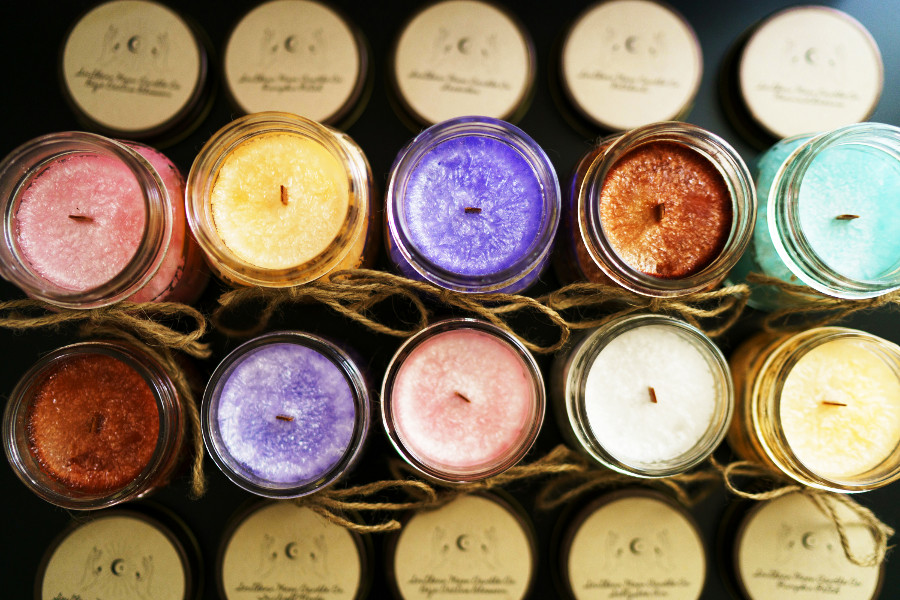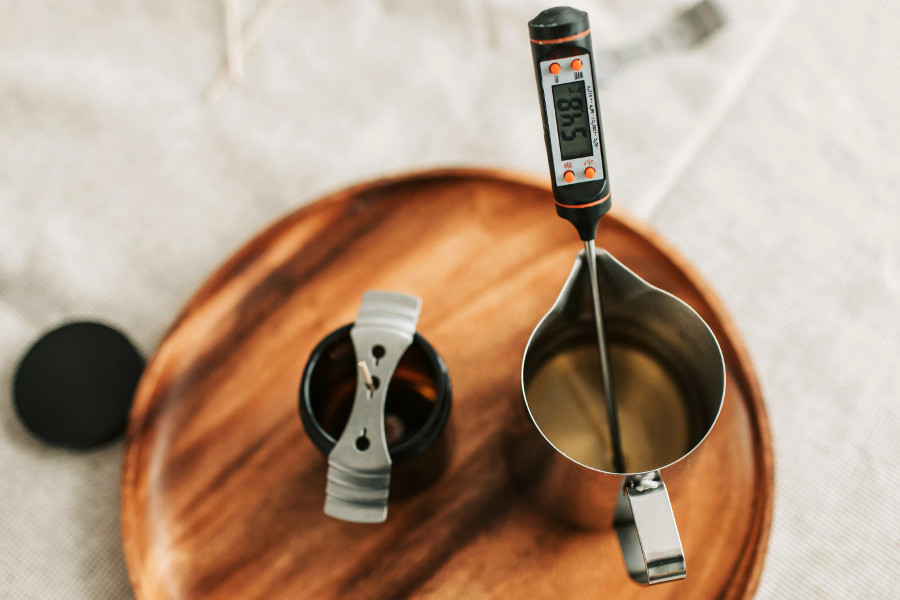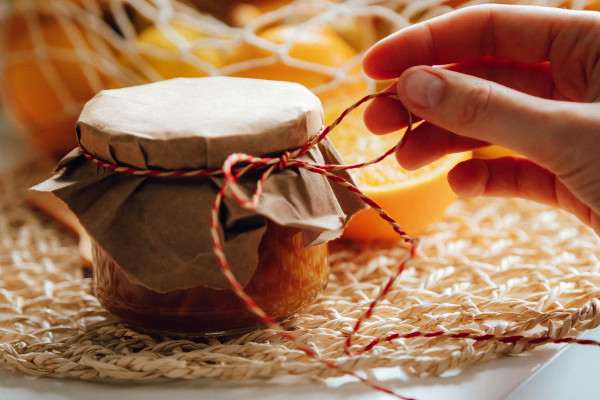How to Get Started in Candle Making? - Tips, Techniques and Materials Explained for Beginners
If you're new to candle making and eager to get started, you're in the right place! This guide will answer the most frequently asked questions about candle making for beginners, providing you with all the tips and tricks you need to create beautiful, personalized candles at home. Whether you’re curious about the best wax to use, how to add color or fragrance, or how to troubleshoot common issues, we’ve got you covered. Ready to unlock your creativity and dive into this relaxing and rewarding craft? Let’s get started!

1. What do I need to start making candles at home?
So, you want to dive into the world of candle making? Perfect! Getting started is easy. All you really need are the basics: wax (soy, beeswax, or paraffin), a wick (choose one that suits your wax), a container or mold, a thermometer to keep track of temperatures, and some fragrance oils if you want to add that beautiful scent. Don’t forget a double boiler or microwave-safe container to melt your wax, plus a stirring stick for good measure. Oh, and if you’re feeling adventurous, add some colorants to make your candles pop!
2. How do I choose the right wax for candle making?
Choosing the right wax is crucial to your candle-making success. If you’re just starting out, soy wax is a solid choice. It’s easy to work with, burns clean, and holds fragrance well. Beeswax, though a bit trickier, gives your candle a lovely natural scent and is eco-friendly. Paraffin wax is popular for its versatility, but it can leave a bit more soot behind. You also have options like palm and gel wax, but start with the basics and explore from there to see what you like best.
3. What are the best scents for homemade candles?
When it comes to scenting your candles, the options are endless! Lavender, vanilla, and eucalyptus are always winners for a soothing, relaxing vibe. If you’re into something fresher, try citrus scents or fresh herbs. Want to get creative? Blend fragrances like cinnamon and apple for a cozy, fall-inspired candle or mix jasmine and rose for a floral touch. Just make sure the fragrance oils you choose are compatible with your wax, and soon enough, your house will smell amazing!
4. Can I use old candles to make new ones?
Absolutely! You don’t have to throw out your old, half-burned candles. In fact, recycling them is a great way to give them new life. Simply melt the old wax in a double boiler, strain out any bits of wick or debris, and pour it into a new mold or container. You can even add fresh fragrance or color if you like. However, be mindful of the old scent that’s still in the wax – it might carry over into your new candle!
5. How do I add color to my candles?
Adding color to your candles is a fun part of the process! You can easily add liquid dye to your melted wax for vibrant results. A few drops are all you need, and you can stir it in until it’s perfectly even. For a more textured look, you can use crayon shavings (though they may affect the burn). Keep in mind, always use dyes that are safe for candle making to ensure your candles burn properly and safely. Your creativity is your only limit here!
6. What are the basic candle making techniques?
Making candles is all about melting, mixing, and pouring. Start by melting your wax in a double boiler, keeping an eye on the temperature. Once the wax is fully melted, add fragrance and color, if desired, and stir it all together. Next, pour the wax into your container or mold with care, making sure the wick stays centered. Let your candle cool and harden, and once it’s solid, trim the wick, and your handmade creation is ready to go.

7. How long does it take to make a candle from start to finish?
Making a candle doesn’t take all day – usually, you’ll need about 3 to 4 hours. This includes melting your wax, mixing in fragrance and color, pouring the wax, and letting it cool. The actual pouring and setting time can vary depending on the size and type of wax, but generally, your candle should be ready within a few hours. The real beauty of it? You can use this time to get creative with different molds, scents, and colors.
8. What is the best container for homemade candles?
When choosing a container for your homemade candles, it’s important to consider safety first. Glass jars are a classic choice – they let you see the candle burn and add a touch of elegance. But if you’re looking for something more rustic, ceramic, metal tins, or even concrete molds can create interesting textures and designs. Just ensure the container can withstand the heat, and always make sure your wick is the right size for the container you choose.
9. How do I make candles without a mold?
No mold? No problem! You can easily make candles using everyday containers like glass jars, mugs, or even a cupcake tin. All you need to do is secure your wick at the bottom, melt the wax, and pour it into whatever you’ve got. The beauty of it is that your candles will take on the shape of whatever container you choose, giving them a unique, personalized touch. Be creative and experiment with different materials to find what works best for you.
10. What kind of wick should I use for different types of candles?
The wick you choose depends on the size of your candle and the type of wax. Cotton wicks work well for soy and beeswax, while wooden wicks can give your candle a charming crackle. Bigger candles require bigger wicks to ensure they burn evenly, while smaller candles need smaller wicks. It’s all about finding the right balance between wick size, wax type, and container size. Trial and error might be needed, but that’s part of the fun!
11. How do I prevent my candles from tunneling?
Tunneling is the enemy of a perfect candle burn. To avoid it, make sure to burn your candle long enough during its first use so that the melted wax reaches the edges. If your wick is too small for the candle, that could also cause tunneling, so try adjusting the wick size if necessary. Burning your candle for short periods can lead to uneven burning, so give it time to fully melt the top layer for a smooth, even burn.

12. How do I store candles to keep them fresh?
To keep your candles in tip-top shape, store them in a cool, dry place away from direct sunlight. Heat and light can alter the appearance and scent of the wax, so a closet or cupboard works perfectly. For extra care, store your candles in their original containers or wrap them in plastic to keep them dust-free and fresh. This helps maintain their fragrance and keeps the wax in good condition until you're ready to light them up.
13. Can I make candles with essential oils?
Absolutely! Essential oils are a fantastic way to give your candles a natural scent. Lavender, eucalyptus, and peppermint are popular options, but you can get creative with whatever oils you like. Just keep in mind that essential oils are more potent than fragrance oils, so use them sparingly. They should be mixed with the wax at the right temperature to ensure the scent blends in evenly. This adds a luxurious, aromatic touch to your handmade candles.
14. How do I make candles for gifts or as a business?
If you're making candles for gifts, think about packaging! Use attractive containers, unique scents, and maybe even personalized labels. For business purposes, focus on consistency and quality. Offering a variety of scents, sizes, and styles can help appeal to different customers. Whether you’re selling at markets or online, good branding and effective marketing can make your candle-making hobby into a profitable venture. Make sure each candle burns evenly and safely – after all, quality is key to happy customers. There are many e-commerce platforms where you can sell your candles. Here are a few from the popular ones: Etsy, Shopify, Amazon Handmade. Of course, you can create your own website, as well, to sell directly to your customers.
15. How can I troubleshoot common candle making mistakes?
We all make mistakes – especially when we're learning something new. If your candles aren’t burning right, check the wick size. A wick that’s too small can cause tunneling, while one that’s too big might lead to smoking. If your wax has an uneven texture, it’s likely that it cooled too quickly, so be mindful of pouring temperatures. When in doubt, experiment with different techniques, and don't be afraid to try again. Each candle is a learning opportunity!
Good luck with your adventures in candle making.



